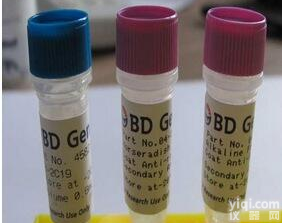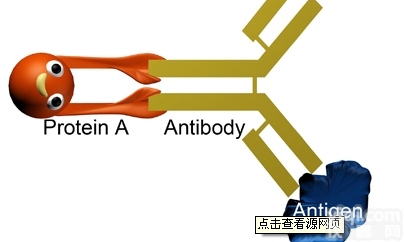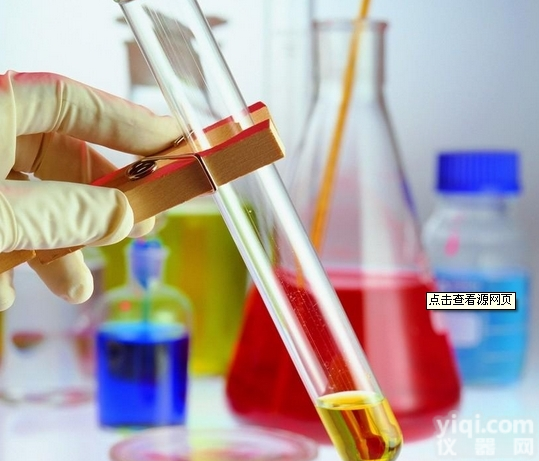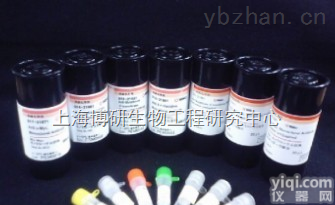产品名称:嘌呤霉素敏感性氨肽酶蛋白抗体,Anti-PSAP抗体
中文名称:嘌呤霉素敏感性氨肽酶蛋白抗体
英文名称:Anti-NPEPPS/PSAP
产品编号:byk-11684R
产品规格:0.1ml/0.2ml
产品用途:科研实验
亚 型: IgG
贮 存: 贮存于-20℃
抗体的异质性。抗体的组成极为复杂,是由成千上万、多种多样的免疫球蛋白(Ig)分子所组成。这些Ig分子在形状、大小、结构以及氨基酸的组成和排列上,既相似,又有差别。由于有差别,它们的电泳活性就有很大的变化。
嘌呤霉素敏感性氨肽酶蛋白抗体,Anti-PSAP抗体 产品说明:
Puromycin-sensitive aminopeptidase is a 100kDa zinc metallopeptidase which degrades neuropeptides by removing amino acid residues from the amino-terminus. The protein is the most abundant aminopeptidase in the brain, however it is not exclusive to that organ. It is localized primarily in the cytoplasm, and plays a role in the metabolism of neuropeptides in nerve terminals and synaptic clefts. The human PSA gene maps to chromosome 17q 2-32.
保存条件:Store at -20 °C for one year. Avoid repeated freeze/thaw cycles. The lyophilized antibody is stable at room temperature for at least one month and for greater than a year when kept at -20°C. When reconstituted in sterile pH 7.4 0.01M PBS or diluent of antibody the antibody is stable for at least two weeks at 2-4 °C.
嘌呤霉素敏感性氨肽酶蛋白抗体,Anti-PSAP抗体 关产品:
Anti-SLC4A4(solute carrier family 4:sodium bicarbonate cotransporter NBC1) 碳酸氢钠协同转运蛋白4-A4抗体
Anti-Slc4a7/Nbcn1(solute carrier family 4, sodium bicarbonate cotransporter, member 7) 碳酸氢钠协同转运蛋白4-A7抗体
Anti-Slc22A17 (solute carrier famili 22A17) 可溶性载质转运蛋白22A17抗体
Anti-SLC24A5 (solute carrier family 24, member 5) 可溶性载质转运蛋白SLC24A5抗体
Anti-Slc26a5/Prestin 外毛细胞运动蛋白/可溶性载质转运蛋白Slc26a5抗体
Anti-SLC6A19 (Solute carrier family 6, member 19) 钾依赖钠钙交换蛋白6
Anti-Smac/DIABLO(the second mitochondrial activator of caspase) 线粒体促凋亡蛋白抗体
Anti-SLC33A1(Acetyl-coenzyme A transportor 1) 乙酰辅酶A转运蛋白1抗体
Anti-SLC34A2/NaPi-2b(Solute carrier family 34 member 2) 磷酸钠协同转运蛋白抗体
Anti-SMN1(survival of motor neuron 1) 运动神经元生存蛋白1抗体
抗原修复——原因 *常规的石蜡切片标本均用甲醛固定,结果使得: -抗原性物质形成醛键、羧甲键而被封闭了部分抗原决定簇; -蛋白之间发生交联而使抗原决定簇隐蔽。 *要求:在染色时,需要先进行抗原修复或暴露,即将固定时分子之间所形成的交联破坏,而恢复抗原的原有空间形态抗原修复——方法 *化学方法 *加热方法 -水浴加热法 -微波照射法 -高压加热法 -酸水解法
抗体规律
(1)初次反应产生抗体:当抗原一次进入机体时,需经一定的潜伏期才能产生抗体,且抗体产生的量也不多,在体内维持的时间也较短。 (2)再次反应产生抗体:当相同抗原第二次进入机体后,开始时,由于原有抗体中的一部分与再次进入的抗原结合,可使原有抗体量略为降低。随后,抗体效价迅速大量增加,可比初次反应产生的多几倍到几十倍,在体内留存的时间亦较长。 (3)回忆反应产生抗体:由抗原刺激机体产生的抗体,经过一定时间后可逐渐消失。此时若再次接触抗原,可使已消失的抗体快速上升。如再次刺激机体的抗原与初次相同,则称为特异性回忆反应;若与初次反应不同,则称为非特异性回忆反应。非特异性回忆反应引起的抗体的上升是暂时性的,短时间内即很快下降。
 嘌呤霉素敏感性氨肽酶蛋白抗体,Anti-NPEPPS/PSAP抗体
嘌呤霉素敏感性氨肽酶蛋白抗体,Anti-NPEPPS/PSAP抗体
 进口/国产 CD13抗体,CD13氨肽酶N抗体
进口/国产 CD13抗体,CD13氨肽酶N抗体
 CD13抗体*CD13氨肽酶N抗体FITC.PE
CD13抗体*CD13氨肽酶N抗体FITC.PE
 Anti-CD13抗体,CD13氨肽酶N抗体
Anti-CD13抗体,CD13氨肽酶N抗体
 Anti-CD13抗体,CD13氨肽酶N抗体
Anti-CD13抗体,CD13氨肽酶N抗体
 Anti-CD13抗体,CD13氨肽酶N抗体
Anti-CD13抗体,CD13氨肽酶N抗体
 CD13抗体 CD13氨肽酶N抗体
CD13抗体 CD13氨肽酶N抗体
 CD13抗体 CD13氨肽酶N抗体
CD13抗体 CD13氨肽酶N抗体
 Anti-CD13抗体,CD13氨肽酶N抗体说明书
Anti-CD13抗体,CD13氨肽酶N抗体说明书
 P2Y1受体抗体免疫组化|嘌呤受体抗体免疫组化
P2Y1受体抗体免疫组化|嘌呤受体抗体免疫组化
 Anti-MGMT抗体,O6甲基鸟嘌呤DNA甲基转移酶抗体价格
Anti-MGMT抗体,O6甲基鸟嘌呤DNA甲基转移酶抗体价格
 Anti-Nmnat1抗体,烟酰胺腺嘌呤二核苷酸酶1抗体价格
Anti-Nmnat1抗体,烟酰胺腺嘌呤二核苷酸酶1抗体价格